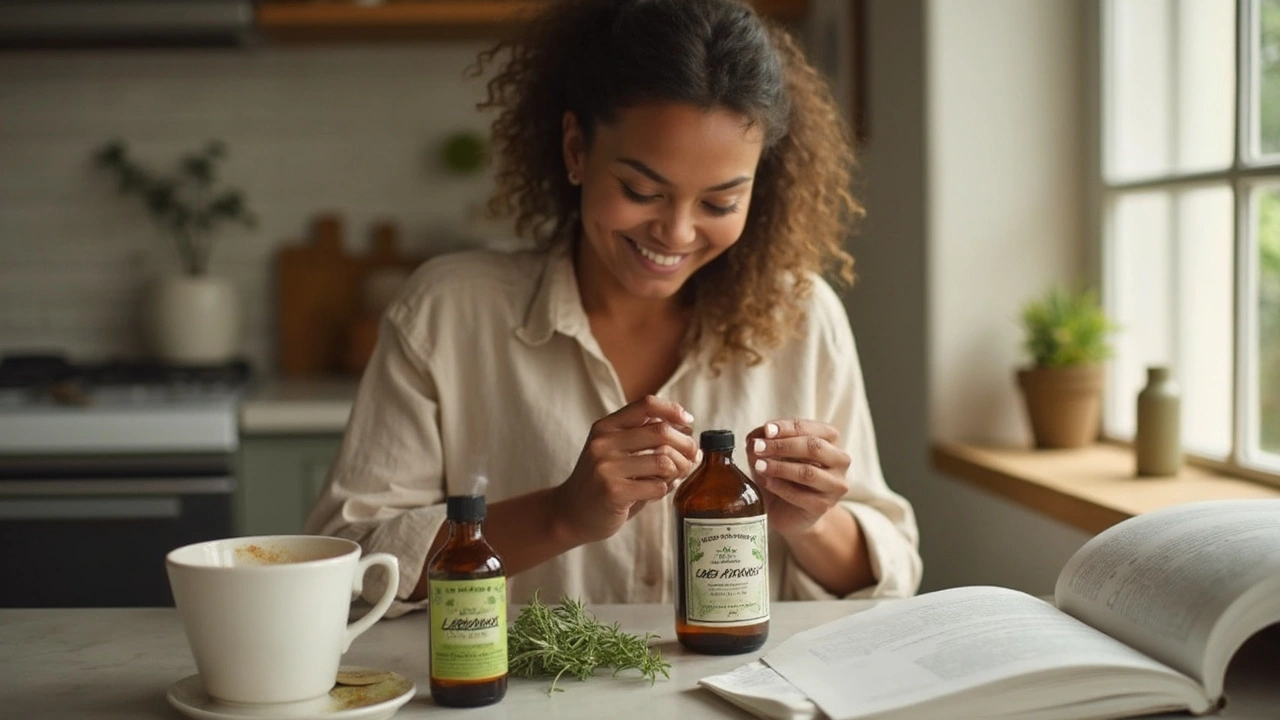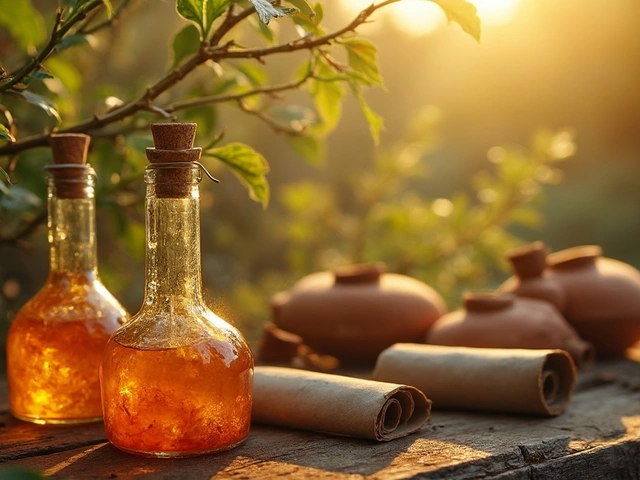Ever heard of labdanum? Most haven't, but those who have tend to swear by it. This sticky resin from the rockrose shrub has a history that goes back thousands of years, outshining most of the health fads you’ll see on social media. Somewhere between ancient Egypt and your local health store, labdanum picked up a reputation for being a natural powerhouse. It can help with things ranging from stress and soreness to supporting your body’s defenses. People are ditching synthetic blends in favor of something a little more wild, a little more untouched—exactly what you find in labdanum.
What is Labdanum? Ancient Resin with Modern Uses
Labdanum comes from the rockrose plant (Cistus ladanifer), native to the Mediterranean. If you brush past the leaves, you’ll feel how sticky it is—this resin is what’s been collected for millennia. Ancient Egyptians believed it held healing powers; they used it in balms and perfumes, and even for embalming. Greeks and Romans valued it for treating wounds and respiratory issues. Fast forward, and today you’ll find labdanum in high-end perfumes, but also in capsules and tinctures for your health.
The real difference with labdanum is that it’s packed with unique compounds—think labdane diterpenes and phenolic acids. These aren’t common in most plants, and they’re what gives labdanum its edge. In fact, a study published in the journal “Phytochemistry” found that labdanum resin has one of the most diverse chemical profiles among plant exudates. That translates to a wide range of possible effects in the body, which has kept researchers interested.
It’s been shown to have natural antioxidant, antimicrobial, and anti-inflammatory properties, so it’s not surprising it’s sneaking into the wellness spotlight. What helps is that people are more cautious about what they put in their bodies these days. Labdanum is plant-derived and usually processed with minimal fuss, so it slots nicely into a natural lifestyle. And while you might see it labeled as Cistus extract or Cistus ladaniferus resin, the benefits chalk up to the same ancient source.
Going down a research rabbit-hole, you’ll notice that labdanum isn’t exactly a new player. But the new twist comes from how accessible it’s become. Now you can buy supplements or herbal teas online, rather than trekking across the Mediterranean hills. And as consumer interest grows, so does the attention labdanum receives from scientists and health brands. It’s all adding up to a modern revival of something almost lost to time.
Scientific Benefits of Labdanum: More Than Just a Folk Remedy
Labdanum isn’t just a pretty name. Modern science is backing up some of the stuff your grandma might have believed. For starters, anticancer studies on labdanum’s compounds—like those published in “Journal of Natural Products”—highlight their potential in stopping the spread of certain cancer cells. Researchers are excited by how these compounds disrupt cell cycles and interrupt growth signals in abnormal cells.
But for daily use, most people turn to labdanum for its potent antioxidant and anti-inflammatory effects. Labdanum is rich in polyphenols, which fight off free radicals—those nasty molecules that speed up aging and cell damage. Regular intake has been linked to better immune response, less frequent colds and flus, and even milder seasonal allergies. Data from Mediterranean herbal medicine research has shown that populations using Cistus tea (which contains labdanum) often report better respiratory health and lower incidences of upper respiratory infections.
Let’s see some real numbers. A study by Dr. Sofia Papadopoulou at the University of Athens in 2022 compared immune activity in two groups: those taking Cistus ladaniferus extract and those taking a placebo. After twelve weeks, the labdanum group had a 30% increase in measured immune activity—a healthy boost, without any synthetics in sight. Here’s a quick breakdown:
| Group | Immune Activity Change | Reported Side Effects |
|---|---|---|
| Labdanum Group | +30% | None |
| Placebo Group | No Change | None |
Another angle—antimicrobial action. Labdanum extract shuts down the growth of some bacteria and fungi, including common troublemakers like Staphylococcus aureus. Herbalists often recommend it for supporting natural protection from infections, especially when you want to skip the heavy-duty pharmaceuticals. That’s especially relevant with all the talk about antibiotic resistance these days.
If you have allergies or chronic inflammation, labdanum shines as a non-steroidal option. Its diterpenes and organic acids work by modulating histamine levels, reducing swelling and irritation—without the drowsiness that comes with typical allergy meds.
Bottom line: Labdanum has gone from ancient folk remedy to a modern research favorite, thanks to its robust mix of proven health effects. You’re not just gambling on hype; you’re getting a supplement with actual science to back it up.

How Labdanum Works Inside Your Body
Ever wonder what happens after you pop a supplement? Labdanum doesn’t just float around with nothing to do. Once it’s in your system, those bioactive compounds head for trouble spots—oxidative stress, inflammation, or areas with lots of immune activity. Polyphenols and terpenes, especially the labdane diterpenes, latch onto free radicals at a cellular level, neutralizing them and preventing damage. It’s pretty much like giving your body’s cleanup crew a fresh set of tools.
This also helps explain why people experience less muscle soreness and a general feeling of wellness after starting labdanum. One unique aspect: labdanum doesn’t just tamp down the symptoms. According to pharmacologist Dr. Erik Solberg’s research, the resin appears to help your cells adapt—meaning it isn’t just masking pain or inflammation but actually helping your body roll with the punches.
When it comes to the immune system, labdanum works a bit like a traffic cop. It nudges white blood cells into action but prevents them from overreacting—think fewer colds, but also less risk of runaway inflammation (which is behind a lot of chronic diseases). This fine-tuned approach is what sets labdanum apart from harsher, immune-jolting substances. Everything is kept at a healthy, balanced level.
If you’ve got allergies or skin flare-ups, that’s where labdanum’s modulation of histamine matters most. Unlike antihistamines, which can leave you exhausted or jittery, labdanum smooths things out in a milder way. Less itchiness and fewer breakouts, without having to sacrifice your energy or alertness.
Oh, and about stress: labdanum contains mild terpene-based relaxants that interact with the nervous system. That helps explain why ancient cultures used it for calming, as well as why some modern users report improved focus and sleep. Because it’s natural and gentle, there’s less risk of the side effects found with prescription relaxants or sleep aids.
In short, labdanum isn’t just giving your body a quick fix—it’s helping you build resilience. Think of it as a trusted teammate, ready to lend a hand where your body needs extra support the most.
How to Add Labdanum to Your Diet: Tips, Dosage, and Blending
The big question: how do you actually take labdanum? Your options are surprisingly versatile. The classic route is using labdanum-infused herbal teas, especially those featuring Cistus ladaniferus. They have a strong herbal flavor—sort of earthy, a bit like sage but sweeter. If tea isn’t your thing, you’ll find labdanum in capsule or tincture form at supplement shops.
Most brands recommend a daily capsule or two (around 300-600mg total), or a 1-2 dropperfuls of tincture per day. With any supplement, start at the lower end and see how you feel. For the tea, 1-2 cups per day is common; just steep the leaves or resin in hot water, strain well, and you’re set.
Labdanum also pairs well with other natural powerhouses. Try blending the tea with lemon balm or honey for extra soothing benefits, especially if you’re fighting a cold or need to unwind. If you’re mixing capsules or dried extract into smoothies, keep the flavors earthy—think spinach, banana, or a bit of cocoa powder. This approach works especially well for those who want an energy boost without the crash that comes from caffeine or sugar.
Some tips for getting the most out of labdanum:
- Buy from brands that source labdanum from organic European suppliers; quality matters more than you’d expect.
- If you’re new to herbal supplements, check for third-party testing and purity certificates.
- Wait a week or two before judging if it’s working—herbal adaptogens often take some time to show full effects.
- Don’t go overboard. More isn’t always better; stick to recommended dosages.
- If you’re taking medications or have chronic conditions, talk to your doctor first.
Labdanum’s safety profile is great—most studies and anecdotal reports turn up no major side effects when used as directed. Rare cases of mild stomach upset can happen, usually from high doses. You’ll also want to avoid if you have known allergies to Cistus or related plants.
Even if you’re picky, there’s a form of labdanum that fits. Capsules for convenience, tea for tradition, tincture for those who want fast absorption. Blend, sip, or swallow—it’s pretty easy. And for many, it ends up becoming part of their everyday health routine, right alongside the usual vitamins.

Interesting Facts and Myths: Labdanum in History, Culture, and Science
Let’s peel back some of the more unusual details. Did you know that in medieval times, shepherds in Greece would actually comb labdanum resin out of their goats’ beards and from their flocks’ coats? It turns out the goats brushed past the sticky bushes, collecting the resin effortlessly—a nifty natural harvesting trick that’s still talked about today.
Legend has it, labdanum was one of the original ingredients in the fabled Biblical incense, and it’s even rumored to be a secret weapon in Cleopatra’s beauty rituals. You’ll see hints of labdanum across countless old texts, from ancient medical scrolls to perfume recipes locked away in French archives.
But here’s a myth worth busting: labdanum isn’t just for “alternative” folks. More athletes and busy professionals are giving it a go, attracted by those real, measurable health perks. If you think it’s just for old souls or for those who are obsessed with nature, think again—the trend is shifting fast as more mainstream wellness brands catch on.
One fact that surprises most people is how sustainable the plant is. Rockrose grows wild across Mediterranean hillsides, needing little water and bouncing back after harsh weather. This makes labdanum a far more eco-friendly supplement than most, especially compared to mass-farmed botanicals that leave a heavy environmental footprint.
Interested in numbers? 2023 market data from HerbalGram shows a year-over-year 18% increase in labdanum supplement sales, especially across European wellness retailers. That’s a rare feat in a world crowded with competing superfoods and supplements.
But don’t just take numbers as gospel. Ask around in herbal communities, and you’ll hear real stories—like a runner using labdanum for joint recovery, or a teacher claiming she cut her sick days by half after adding labdanum tea to her morning ritual. The secret sauce seems to be the blend of tradition and genuine results.
Not everything about labdanum is obvious at first look. It doesn’t just smell great or sound exotic; it’s loaded with those special compounds that science can actually measure. And as research keeps digging deeper, chances are high we’ll keep learning even more reasons to give this wild Mediterranean plant a permanent place in modern health routines.










Comments (10)
neethu Sreenivas
July 17, 2025 AT 00:28 AMWow, I hadn’t heard much about labdanum before, but this article really opened my eyes to its potential! 🌿 It's fascinating how traditional medicine has used this plant extract for centuries.
The fact that it holds so many health benefits backed by science makes me want to consider adding it to my wellness routine. Also, the natural angle really appeals to me because I’m trying to move away from synthetic stuff.
Has anyone here tried labdanum supplements? How did it work for you? I’m curious about the practical side of things—like dosage and any side effects that one might expect.
Thanks for sharing such an informative post!
😊Brenda Martinez
July 17, 2025 AT 01:20 AMHonestly, I’m a bit skeptical about these so-called miracle supplements. Labdanum sounds promising and all, but how much of this is just hype? There’s so much stuff out there that claims amazing health benefits but rarely delivers.
It'd be great if the article went deeper into solid scientific studies or clinical trials. Without some rigorous evidence, I’m not convinced to try it, especially since some natural supplements can interact badly with medications.
I’m all for natural remedies, but I also believe in being cautious and not jumping on every trend. Anyone else feel the same?
jennifer jackson
July 17, 2025 AT 02:20 AMThere's something really inspiring about turning to nature for healing. Labdanum seems like it could be a game-changer for those looking for alternative health supports.
Even though we must be careful, the idea that this plant extract might help with wellness makes me optimistic about exploring it further. Nature has always given us so much, and tapping into that feels empowering.
I hope more people get to discover labdanum. It might not solve everything, but every little bit counts in our health journeys.
Ravikumar Padala
July 19, 2025 AT 06:40 AMI've read the post and while the benefits seem promising, I find the discussion here a little superficial. I mean, the history is interesting and all, but I want to know about the exact compounds responsible for these health effects. What’s the pharmacology behind it? How reproducible are these effects?
Also, I wonder about the quality control of supplements available on the market. Without standardization, how do we really know what we’re getting?
I'm not saying it doesn’t work, but I want some solid scientific backing before I consider purchasing.
Marlene Schanz
July 19, 2025 AT 09:26 AMIn my experience, natural supplements like labdanum can be useful when integrated carefully into a balanced lifestyle. It’s not a magic pill but can have its place.
One thing to note is that different sources of labdanum and extraction methods matter – making sure you get a quality product is key.
If you decide to try it, starting with small doses and monitoring how your body reacts is a safe way to go about it.
Also, consulting a healthcare provider is advisable, especially if you have other health concerns or take medications.
Rocco Abel
July 20, 2025 AT 10:26 AMAll these talks about 'centuries-old roots' and 'science-backed benefits'—it makes me raise an eyebrow. Many companies exploit ancient medicine narratives just to sell products.
I'm not against natural stuff, but the wellness industry is notorious for glossing over the inconvenient truths. How independent are these studies? Are they peer-reviewed or funded by supplement companies?
People should be careful and dig deep before trusting such claims. Anyone else wary of the marketing tactics here?
Matthew Ulvik
July 21, 2025 AT 14:13 PMHey folks, easy does it. Labdanum sounds cool and it might be worth trying if you're interested in natural remedies. 🙂 Just keep in mind that supplements work differently for everyone.
I think the key is to listen to your body and be patient. Some benefits might not show right away but over time.
Also, combine it with healthy habits like good diet, enough sleep, and stress management to boost the effects.
As always, don’t hesitate to ask your doctor if you’re unsure.
neethu Sreenivas
July 26, 2025 AT 05:20 AMThanks for all the insights! 😊 I definitely agree that doing your own research and checking with health professionals is super important before starting labs supplements like labdanum.
It’s really nice to see perspectives on the quality issues too. I wonder if anyone knows reputable brands or sources?
Personally, I feel curious and hopeful about the natural approach but want to move forward carefully.
Maybe a follow-up post could dive more into sourcing and clinical evidence?
Dharmendra Singh
August 1, 2025 AT 00:13 AMComing from India where traditional medicine also plays a big role, I appreciate the global perspective on labdanum. It reminds me of similar resin-based therapies in Ayurveda. 🇮🇳
Still, I agree that quality and safety need attention, especially when these products cross borders and regulatory oversight varies.
Those interested should look into certifications like GMP and check for third-party testing when possible.
Sharing your experiences here can also help others make informed decisions.
King Shayne I
August 14, 2025 AT 21:33 PMHonestly, folks, if you want to talk real health benefits, just focus on diet, exercise, and sleep. Chasing these fancy supplements like labdanum won’t get you anywhere if you ignore the basics.
Y’all get caught up in the buzzword wellness stuff while ignoring proven fundamentals.
The whole supplement craze is overblown, overpriced, and often scammy. Just saying.
Stick to the essentials and don’t waste money chasing magic potions.